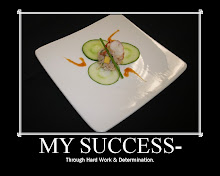Today I looked up an author for the New York Times; his name is Harold McGee writes about a variety of topics. He also has a lot of food based discussions too. One article that stood out as interesting was his article “Fruit Gets Dressed Up as Caviar.” The original article was written on March 22, 2006.
The article discussed the combination of food with three chemicals: Sodium Alginate, Sodium Citrate, and Calcium Chloride. The three chemicals combined in the right ratio can cause a sphere of yummieyness. The Sodium Citrate is also used as an anti-coagulant in the ice cream making industry. As for the Sodium Alginate it is used as a gelling agent when making preservatives.
The Breakdown:
The food product (weather it’s a fruit or vegetable) gets pureed down and sifted through a chinois to remove any sort of fibrous impurities. From there the process requires the bright white powder Sodium Citrate to be sifted together with the off white slightly tan powder, Sodium Alginate; and then mixed with puree.
Then the calcium chloride is blended into a solution with water. From there, you take a marinade injector or an eye drop applicator and fill it with the food puree, Sodium Alginate, and Sodium Citrate. Slowly one drop at a time drop the blend into the Calcium Chloride water. As it hits the substance will create a tear size ball.
The Reaction Breakdown:
The article “Fruit Gets dress UP as Caviar” did not talk about what causes the reaction, so I did further research. Since Chef Chemist Ferran Adria was the first to discover and apply this chemical reaction, I started with google.com and his name. That really didn’t supply much information. So the next search I looked up as “the science behind fruit Caviar” What I discovered is, the anti-coagulant (Sodium Citrate) creates heat as the solution hits and reacts with the Calcium Chloride. So in the right balance, the Calcium Chloride will cook the Sodium Alginate into a barrier around the remainder of the droplet, and at the same time the center will remain liquid, so as McGee described it as ”itsy-bitsy bursts of intensified flavor in your mouth, simulating a slightly tingly effervesce.”
So in turn, the “caviar” has an eggshell around a soft embryo of puree that stayed uncooked. The wrong solution can create a fun different response. Too much Calcium Chloride will cause too much heat and cook the droplet straight though into a firm solid bead of gelatinized puree. Too little can create a “pasta-less ravioli puree.” The sack of puree would not hold a defined shape it would roll and plop around a like a stop and shop bag filled and tied half full of water.
While I was reading about the fruit caviar the thought of application popped into my head. “What if…” was my main thought pattern. An example is”What if I could make a tear drop Tabasco caviar for oysters on the half shell.” Or “What if I could make chocolate caviar into a bite size S’more with a custom gram cracker shell the size of a dime,” but these are for another journal on another day after another session of cruising the internet. Until then I will wait for my Sodium Alginate, Sodium Citrate, and Calcium Chloride to come.
Until later with a fun food based entry,
This is Jason Soko CC signing out,
Goodbye and Happy Cooking!
Monday, April 4, 2011
Subscribe to:
Post Comments (Atom)

No comments:
Post a Comment